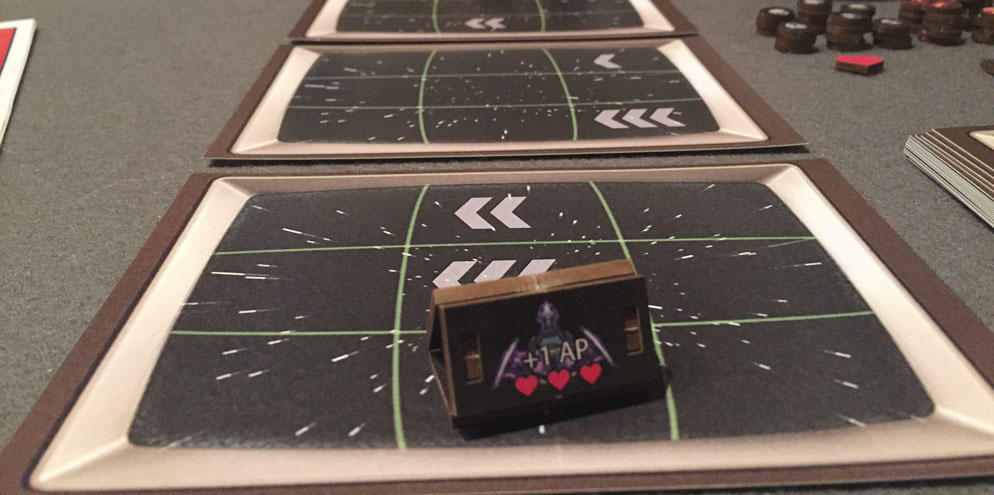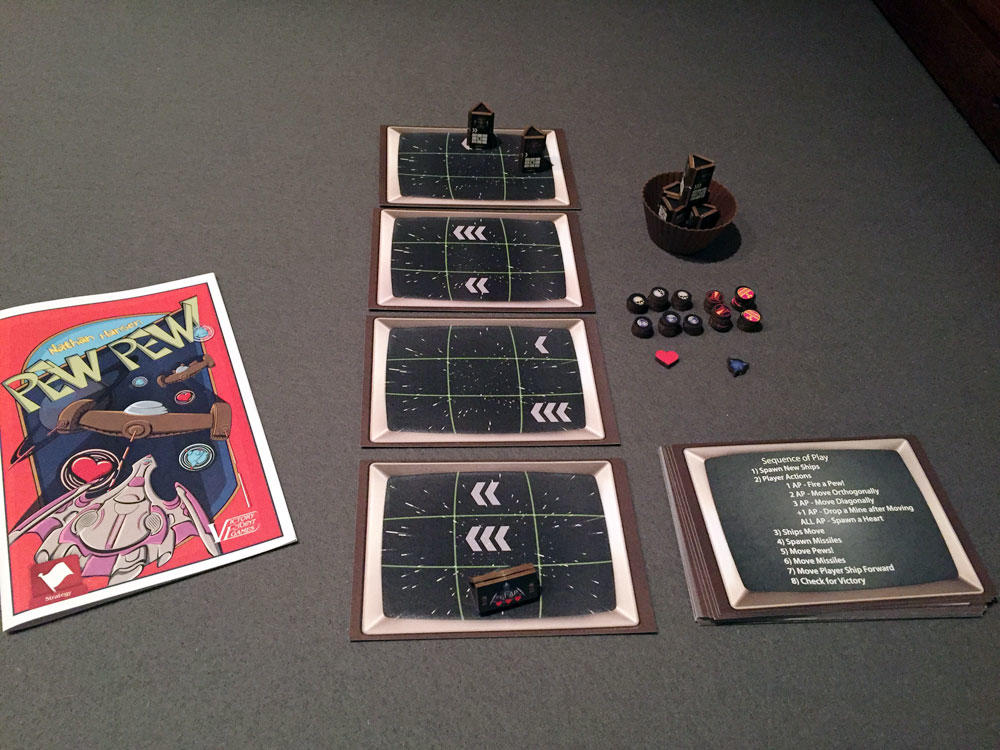
 I will confess that I grew up in the eighties at the height of arcade video-gaming (insert ageism joke here). The digital glow of those large boxes or table tops drew me in like nothing else. My all-time favorite arcade game was Galaxian (not to be confused with Galaga) which I likely spent a king ransom of quarters playing over the years.
I will confess that I grew up in the eighties at the height of arcade video-gaming (insert ageism joke here). The digital glow of those large boxes or table tops drew me in like nothing else. My all-time favorite arcade game was Galaxian (not to be confused with Galaga) which I likely spent a king ransom of quarters playing over the years.
So when I was offered the chance to review, Pew Pew!, a solo, “old-school” arcade space shooter strategy game from Victory Point Games, I jumped at the chance. Does Pew Pew! emulate the feel of my favorite eighties arcade game fun or does it end up missing the mark? Read on!
Pew Pew! is a solitaire game for 1 player that plays between 15-20 minutes.
Game Overview:
You’re a single ship on a mission to stop an endless horde of alien ships from destroying your homeworld. Sound familiar? You will spend action points (AP) to move around the player screens and attempt to blow-up alien ships as they descend upon you and your homeworld. Once your final score is 10, you win. But if your ship takes too much damage or you collect too many death tokens you lose and the aliens succeed on destroying your homeworld.
Game Components:
Pew Pew! comes with decent components. All tokens, markers, and counters are on scale with most Victory Point Games punch outs. These are all full color, functional, and made of a thick card stock so replay is not an issue. Players should use care when punching out the counters thought. They are all laser cut, but it’s a thick stock so be careful not to tear the top art layer of the markers, tokens, and counters.

The Player Screens are cool and the game side totally gives you that eighties arcade feel. The fronts look like a big arcade screen and are gridded to easily outline alien and player movement. They also include chevrons that are easy to recognize for alien spawning and player APs. The back of the Player screens are also great because when face down they provide an easy to refer to sequence of play. This was a good use of space and design, especially for your first play. I thought the Screens were the best component in the game.
I think the overall miss in the components was the Alien Ship artwork. The Player Ship artwork is a great representation of an eighties shooter games but not the Alien Ships. Each Alien Ship token uses identical art for all counters that only differs by color. Victory Point Games could have easily used different designs but instead went with one which was a mistake.
Also this one design doesn’t work for me. Almost all eighties shooter alien ships used an insect design, with bug like shapes, but the Pew Pew! aliens have a more mechanical appearance. This does nothing for that advertised eighties feel. All other components work to give that old school vibe but this one.
How to Play:
The game board consists of a series of game “screen” set in a vertical row. The player’s ship begins at the bottom screen, with the alien ships at the top. Once set-up is complete, the game is played in the following phase order:
1. Spawn Ships Phase: For each set of chevrons on the Screen furthest from the player, draw an Alien Ship and turn it to the matching chevron.

2. Player Actions Phase: the player can perform the following actions but is limited to the number of APs available to them.
- Fire a Pew!: For 1 AP, the player may fire 1 Pew! Token. If chosen, the player places 1 Pew! Token on the adjacent Screen above and in the same position as the Player’s Ship.
- Move Orthogonally: For 2 APs, the player may move the Player Ship 1 space orthogonally.
- Move Diagonally: For 3 APs, the player may move the Player Ship 1 space diagonally.
- Drop a Mine: For +1 AP, as part of your move, the player may drop the Mine Token in the space they are leaving.
- Spawn a Heart: For all AP on a turn, the player may place the Heart Token on any space on the Screen furthest from them.
3. Aliens Move Phase: Alien ships will move around the game board.
4. Spawn Missiles Phase: Missile tokens will enter play from the alien ships.
5. Move Pews! Phase: All Pew! Tokens move 2 Screens away from the player. Keep in mind that the Phew! must remain in the same position when moving from each Screen and moves 1 screen at a time.
6. Move Missiles Phase: All Missile Tokens are moved 1 Screen towards the player, starting with the Token closest to the Player Ship. If a Missile Token moves into the same spaces as the Player Ship, it damages the ship.
7. Move Player Forward Phase: The Player Ship will move to the adjacent Screen in the same position, the now vacant Screen is removed and cleared of tokens. Then slide the three remaining screens down, draw and place a new Screen furthest from the Player Ship.
8. Check Victory Phase: The game ends if the Player Ship has taken 3 hits (has no more health) or accumulated 10 or more Death or Point Markers. The player calculates their final score by their total number of Point Markers minus the total number of Death Markers, once it equals ten either plus or minus the game ends. If the game is not over then return Phase 1 and repeat until it does.

Game Experience:
As I stated in the intro, I loved eighties arcade games, especially space shooters. I will say out of the gates overall that Pew Pew! did emulate the feel of playing an old school arcade game. Much like those eighties arcade games, this one is light on strategy and player involvement is really more reactionary to the Alien Ships and missiles.
This is not a negative for most gamers but I think the light strategy makes Pew Pew! a good game for new gamers or for someone looking for a light game to play. Most heavier strategy games, in my opinion, give players multiple options to plan out, weigh, and try to decide the optimal choices and also allow you plan on your current and advanced turns.

For Pew Pew! the only aspect that you can truly plan is the pending Screen that the Player Ship will gain AP on and the Missile movement. The rest of the action is purely reactionary to the Alien ship spawning and movement. If you are the type of gamer that prefers heavy strategy games, then you might want to pass on this one.
If you do enjoy light games, then I think what you will find most appealing is that the rules are fairly easy to pick up, outside of the Alien Ship and Missile Spawning. Honestly, both of these Phases can be mastered fairly quickly with a few references back to the rules or game plays. Overall, the rules are very straight forward and and shouldn’t take long to pick-up.
The only other aspect that can be viewed as a negative is the luck of the draw of the Screens. Since your action points for a round are determined by what’s on the screen, this can cause some frustration. There were two distinct times where I had three out of five screens where I only gained three or four AP. This limited what I could do that round. I love the player Screens and I don’t want the game to be a cake walk but only having three to four AP for that many Screens in a row is hard to come back from.

I have played many games (and I’m sure you have) where you have to suffer through the luck of the draw and unfortunately that can break you in Pew Pew! as well. If you draw screens with low Action Points, it’s going to set you back. You could try to arrange the deck to spread these out, but I’m only guessing at a solution. I really have no answer.
I will say that the big plus for me is that the game is overall challenging and fun. Just when you think you have your Pew lined up for the perfect shot…MISS…the Alien Ship moves. This can be frustrating but it’s also very rewarding once you are able to successfully blow one up. And I absolutely love the concept of the Heart Token. If you collect one, you gain an additional life and continue the fight. That’s a lift straight out of many eighties arcade games.
Final thoughts:
I feel like the designer did a great job emulating the eighties arcade game experience. Most of the designs, except the Alien Ships, had that old school space shooter look and feel. Pew Pew! can be somewhat challenging to win, as expected with a solo game. The strategy is definitely on the light side and play more reactionary to the Alien Ship and Missile movement.
Serious gamers looking for a heavier strategy game might be turned off by that, but I think it opens the door for new gamers or a gamer looking for a light game. The overall rules are straight-forward and rule book is an excellent reference guide. This will help most gamers to be able to play and likely master it quickly.
If you are a fan of 80’s arcade shooters and like a challenge, than Pew Pew! might be worth a look. As long as you are good with the reactionary nature of the game and can deal with the luck of the draw, there is fun to be had with Pew Pew!
If you are interested in getting a copy of Pew Pew!, you can pick it up for about $25.
Final Score: 3.0 Stars – A good gateway game that is easy to pick-up and fun to play.
 Hits:
Hits:
• Gives you an old school arcade feel
• Easy to learn rules and mechanics
• Replay value for light gamer
Misses:
• Alien Ship art is lacking
• Luck of the draw is significant to game enjoyment
• Light on strategy for serious gamers





















